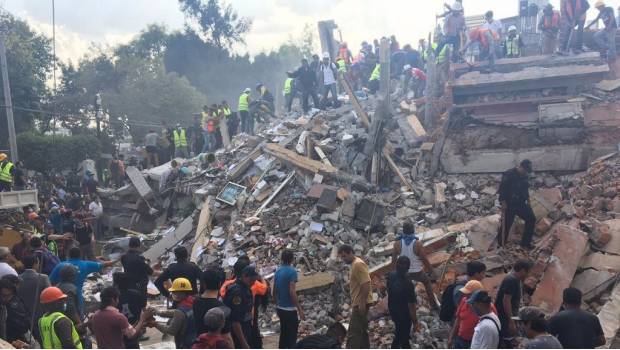Earthquakes in Mexico.
In
Mexico along with other countries, earthquakes are very common and this
is because it is part of the Belt or Ring of Fire, located on the
coasts of the Pacific Ocean and is characterized by concentrating some
of the most important subduction zones of the world, which causes an intense seismic and volcanic activity in the areas covered.
The National Seismological Service in Mexico recorded only 16 thousand 540 earthquakes in the last 12 years, which means that there are almost 4 earthquakes per day in the country.
Throughout the history of Mexico there have been devastating earthquakes of great magnitude:
- One of the largest earthquakes in Mexico was March 28, 1787, on the coast of Oaxaca, with a magnitude of 8.6. It is also known as "The Great Mexican Tsunami," and caused one of the greatest damages in the history of Oaxaca, flooding everything in its path up to six kilometers inland, near what is now Puerto Angel and extended approximately to along the 450 kilometers that cover the Oaxacan coast. The number of casualties was relatively low for a tsunami of this magnitude, but this was because according to documents from the eighteenth century show that the coasts were sparsely populated.
- The earthquake of September 19, 1985, with a magnitude of 8.1, is one of the strongest that has shaken the country, recorded on the coast of Michoacán more than 350 kilometers from Mexico City, affected the central, southern and west of Mexico, in particular to Mexico City. During this earthquake 5,000 people died, but other data show more than 10 thousand deaths, about 50 thousand injured, about 250 thousand people homeless, more than 770 buildings collapsed or severely damaged and economic losses that accounted for 2.1 percent of the Product National Gross Domestic Product (GDP) and 9.9 percent of Mexico City.
- The earthquake of 7.8 that occurred on July 27, 1957, southeast of Acapulco, caused the fall of the monument of the "Angel of Independence" inaugurated in 1920 by Porfirio Díaz, reason why it is known like the Earthquake of the Angel. During this catastrophe there was a balance of: 700 dead and 2,500 wounded. As for the monument, it was restored and reinforced and reopened in September 1958 and has remained intact ever since.
- On March 20, 2012, in Ometepec, Guerrero, an earthquake of a magnitude of 7.4 occurred, generated a tsunami of approximately 1.5 meters in height and a rising of the coast of about 70 centimeters in the town of Punta Maldonado. This earthquake is distinguished by having the largest number of aftershocks recorded in Mexican earthquakes, with 44 events of magnitude higher than 4.5 during the first 30 days following its rupture.
- On April 4, 2010, an earthquake of 7.2 shook Mexicali, Baja California, known as El Mayor-Cucapah, which broke, a fault of lateral right landslide with 120 kilometres of length towards the frontier city. Since 1915, there have been only five earthquakes of magnitude equal to or greater than 7 in the extreme north of the Gulf of Cortes, threatening the region where cities such as Ensenada, Mexicali, Tijuana and the Cerro Prieto geothermal power station exist, which is one of the biggest in the world.
- The Acambay earthquake of magnitude 7 was recorded in Acambay, State of Mexico, extended about 50 kilometers in length and, being shallow, left on the surface of the earth fractures with more than one meter of height. The damages were very important in the region, where the scarce infrastructure and several towns were severely or completely destroyed.
- In 1999 there were two earthquakes, one in Puebla with magnitude of 7 on June 15 and another in Oaxaca on September 30 with a magnitude of 7.5, these earthquakes caused the death of 52 people, in addition to causing the fall of thousands of houses of adobe and generate severe damages to historical monuments, hospitals and schools. According to the observations of these earthquakes, the extent of damage caused by these earthquakes was four times greater than that observed during typical earthquakes of subduction.
- On January 3, 1920, in Xalapa, Veracruz, a 6.4 earthquake killed more than 600 people caused by landslides on the Huitzilapan River, making it the second most deadly in Mexico's history, only after great earthquake of September 19, 1985.
- On the night of September 7, 2017, an earthquake measuring 8.2, with an epicenter to the southwest of Pijijiapan, Chiapas, was felt by about 50 million people for about two minutes. It is the strongest telluric phenomenon registered in the national territory in 100 years, according to the National Seismological Service, 721 aftershocks have been registered, being the greater of 6.1 of magnitude, and the number of victims is of 65 people deceased.
* Being the 32nd
anniversary of the 1985 earthquake, on Tuesday, September 19, 2017, an
earthquake again shakes Mexico, with a magnitude of 7.1 and with an
epicenter 12 kilometers from Axochiapan in the state of Morelos. Several
buildings have fallen and the number of dead until September 20 is 248,
including 32 children who were trapped when a part of the school
"Enrique Rébsamen" collapsed. The Mexicans are
united helping themselves, raising debris and supporting with food,
medicines, objects of personal hygiene, etc.








Comentarios
Publicar un comentario